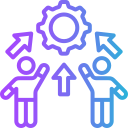
Managing Time Zones in Global Teams
Managing time zones effectively is crucial for any modern business operating across borders. As organizations increasingly adopt remote and distributed work models, employees, clients, and stakeholders often span multiple continents. The challenge is not just about knowing the clock differences; it’s about fostering collaboration, respecting individual work-life boundaries, and maintaining productivity without compromising team unity. Successfully managing time zones in global teams requires strategic planning, clear communication, and empathic leadership. With the right approach, companies can transform potential obstacles into opportunities for innovation and global efficiency.
Understanding the Impact of Time Zones
01
Scheduling Across Borders
Scheduling meetings and projects for globally distributed teams can be a complex endeavor. Overlapping work hours might be limited, meaning key conversations must be carefully timed to accommodate everyone. This scenario often requires more than just picking a time that’s mathematically fair—it means actively considering who is consistently sacrificing personal time for work. Successfully managing this challenge involves regularly rotating meeting times when possible, and making use of asynchronous communication to supplement live conversations. By doing so, organizations demonstrate respect for all members’ schedules, helping prevent burnout and maximize engagement and productivity.
02
Maintaining Project Momentum
Progress doesn’t have to stall just because team members are in different parts of the world. Synchronous collaboration can be difficult, but with proper planning, projects can proceed smoothly around the clock. Teams can use handover strategies, where one group finishes their tasks and passes them along to colleagues in another time zone, creating a continuous workflow. This way, work never truly stops, and deadlines become more manageable. However, to achieve this, teams must develop clear protocols and document all important updates meticulously. Consistency and clarity are the foundations for keeping everyone in the loop and projects on track, regardless of the time on the clock.
03
Addressing Team Morale and Inclusion
Time zone differences can unintentionally leave some employees feeling isolated or less valued. When meetings are always scheduled to suit one region, others may consistently be left out or forced to join at inconvenient hours, affecting morale and inclusivity. It’s vital for leaders to build a culture that acknowledges and compensates for these disparities. This might involve regularly soliciting input from every region about preferred meeting times or finding creative ways for everyone to participate asynchronously. Encouraging cultural respect and celebrating achievements across all time zones helps build a sense of unity and belonging, turning a potential divisive challenge into an opportunity for team strengthening.
Optimizing Communication in Distributed Teams
Choosing the Right Tools
With an abundance of digital tools available, selecting the most suitable platforms for communication and collaboration is essential. Instant messaging apps, collaborative project management platforms, and video conferencing tools all have their strengths and limitations—especially when being used by teams separated by thousands of miles and several hours. A core principle is choosing tools that support both synchronous and asynchronous communication. Features like thread-based discussions, time zone auto-detection, and notification scheduling can make cross-border dialogue more seamless. By prioritizing platforms that are reliable, easy to use, and accessible to all team members regardless of technical proficiency, organizations set the stage for clear and timely communication.
Setting Clear Expectations
Effective communication in global teams relies on transparent protocols about how and when to interact. This means agreeing on reasonable response times, distinguishing between urgent and non-urgent matters, and setting boundaries to protect personal time. Establishing guidelines for sharing updates and feedback helps prevent misunderstandings and reduces frustration, especially when real-time discussions aren’t feasible. Leaders can support this by modeling respectful communication habits and encouraging team members to signal their working hours. By codifying these practices, teams create an environment of trust and predictability, ensuring everyone knows how to reach out and when to expect a reply.
Ensuring Information is Accessible
When team members are online at different times, information must be available whenever someone needs it. Documenting discussions, decisions, and key updates in accessible repositories becomes critical to prevent information silos. Shared drives, knowledge bases, and well-organized project boards allow team members to catch up or contribute without waiting for others to be online. This approach not only maximizes efficiency but also empowers individuals to work independently, reducing bottlenecks and minimizing the risks of important data being lost or overlooked. In this environment, transparency isn’t just a value—it’s a necessary feature for distributed teams to thrive.
Strategies for Fair Collaboration
Rotating Meeting Times
To avoid consistently disadvantaging certain regions, rotating meeting schedules demonstrates fairness and inclusion. Rather than always holding meetings at times convenient for headquarters or a particular region, regularly rotating times ensures everyone occasionally benefits and occasionally makes sacrifices. Transparent scheduling practices reinforce that each team member’s time is valued equally. This strategy requires deliberate planning and clear communication so everyone can prepare accordingly. The result is a more balanced workload, improved morale, and a stronger sense of global unity, with no one group feeling perpetually underserved or overlooked.
Embracing Asynchronous Workflows
Not every decision or update requires a live discussion. By designing workflows that prioritize asynchronous collaboration, teams give everyone the space to think, respond, and contribute in their own time. This can involve using collaborative documents, recorded video updates, and structured feedback forms that allow team members to engage when it suits them best. When asynchronous methods are thoughtfully integrated into company culture, they can reduce stress and empower employees to produce their best work free from time pressure. In turn, this supports a healthier work-life balance and unlocks the full potential of a globally distributed team.
Recognizing Regional Holidays and Customs
Global teams operate across cultures, so understanding and respecting local holidays and customs is crucial for equitable collaboration. Planning projects and deadlines with cultural calendars in mind prevents conflicts and demonstrates genuine appreciation for team members’ unique backgrounds. Leaders can foster inclusivity by educating everyone about significant observances and allowing for flexibility during local holidays. This recognition goes beyond mere logistical convenience—it signals respect, increases engagement, and helps build trust. By weaving cultural awareness into scheduling practices, teams create a more harmonious and supportive work environment.

